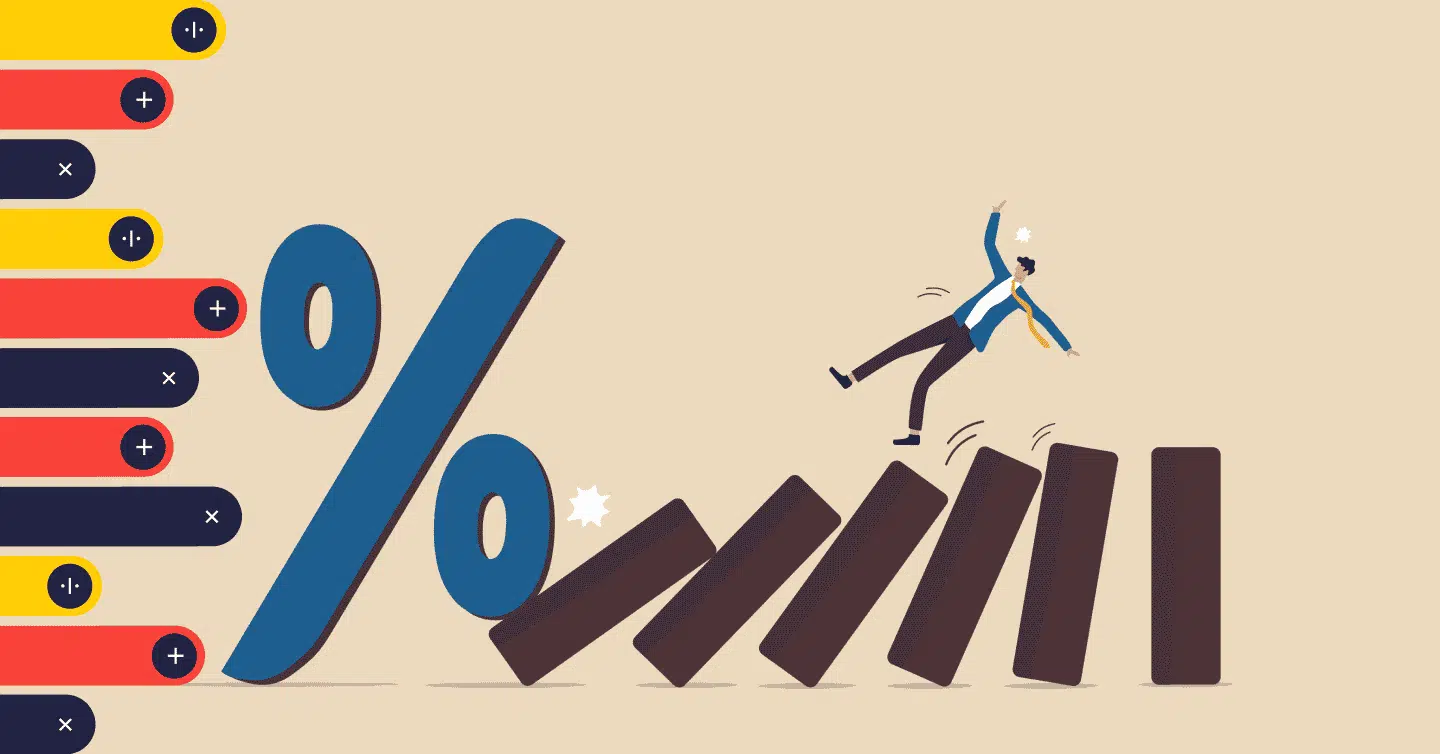A Guide to How Inflation Influences Interest Rates

Table of contents
The Bank of Canada (BoC) aims to keep inflation around a target of 2%. The primary monetary policy tool used to control inflation in Canada involves adjusting the target for the overnight rate, also known as the policy interest rate. When the policy rate is adjusted, this influences all lender prime rates, which are the rates that influence how variable interest rates are priced, including adjustable-rate and variable-rate mortgages.
Bond yields directly impact fixed-rate mortgages, with higher yields making fixed rates more expensive and lower yields less expensive. Yields with corresponding terms impact fixed mortgages of the same term (ex., 5-year bond yields impact 5-year fixed mortgages, 3-year bond yields impact 3-year mortgages, etc.) The market determines a bond’s yield based on monetary policy decisions, inflation expectations, and other economic indicators.
Key Takeaways
- The primary tool used by the Bank of Canada to control inflation involves adjusting the policy interest rate.
- Variable and adjustable rates are priced based on the lender’s prime rates, while fixed rates are based on bond yields with similar terms.
- Like the rest of the economy, interest rates are typically cyclical, meaning they always have highs and lows that balance out over time.
What Causes Inflation?
Inflation is a measure of how much the prices of goods and services rise over time, which results in a decrease in purchasing power. Many factors affect prices and contribute to inflation.
Cost-push inflation occurs when higher prices due to changes in production costs, notably wages and raw materials, cause prices to increase. Increasing production costs are passed on to consumers through increased prices for companies to maintain or increase profit margins, contributing to inflation.
Demand-pull inflation occurs when the demand for a product or service outstrips the supply. When supply can’t keep up with the demand, prices increase in an effort to create a balance in the market.
Built-in inflation occurs when workers expect that inflation will continue to remain high. Workers ask for wage increases that keep pace and offset their higher cost of living due to the impacts of cost-push and demand-pull inflation. When this happens, companies increase the prices of their products or services to compensate for wage increases and maintain profit margins. This, known as the wage-price spiral, creates a persistent loop where workers ask for higher wages due to the high cost of living, and prices increase as a result.
How are Interest Rates Impacted by Inflation?
One of the BoC’s core functions involves setting monetary policy. Monetary policy objectives aim to protect the value of our currency by keeping inflation low, stable and predictable. Monetary policy allows Canadians to confidently make spending and investment decisions while encouraging longer-term economic investments. This contributes to sustained job creation and greater economic productivity, improving our standard of living.
One of the primary tools the BoC uses to keep inflation at the 2% target is the policy interest rate, which influences lender prime rates. When inflation is too high, the policy rate is increased to bring inflation back under control. When inflation is too low, the policy rate is lowered to boost the economy and encourage spending, increasing inflation.
Another tool the BoC can use if policy interest rates are not having the desired effects on the economy is quantitative tightening (QT) or quantitative easing (QE). QT and QE complement the primary monetary policy tool (the policy interest rate), helping to support the economy and reach the inflation target.
Quantitative tightening (QT) can be used in times of inflation to bring demand and supply back to balance when the economy is doing well. With QT, the bank allows government bonds to mature, no longer adding to the demand for bonds. Bonds become cheaper, increasing their yields. Since bond yields with corresponding terms influence fixed interest rates, this makes borrowing more expensive.
Quantitative easing (QE) can be used to help stabilize the economy by making it cheaper to borrow money. With QE, the bank buys government bonds, which raises their prices and lowers their yields. Since bond yields with corresponding terms influence fixed interest rates, borrowing money becomes cheaper, encouraging borrowing and spending.
What are the Impacts of Higher Interest Rates on Borrowing Money?
Higher interest rates mean borrowers pay more for mortgages and other loans over time. Higher interest rates on mortgages erode purchasing power, meaning you qualify for less when borrowing money.
Fixed mortgages have payments that remain the same throughout the loan term. When interest rates are high, borrowers can expect to pay more on the money borrowed, adding to the total interest-carrying costs of the mortgage. Higher interest rates also reduce the qualifying amount, so if you are purchasing a home instead of renewing or refinancing, you will have reduced purchasing power when interest rates are high.
Variable mortgages will realize higher payments immediately if the mortgage is an adjustable-rate (ARM), or the principal portion will be reduced to compensate for higher interest on the mortgage if it’s a variable-rate (VRM), which can increase your amortization.
Note: When interest rates are higher, households and businesses tend to borrow and spend less, which eases demand in the economy, helping soften inflationary pressures.
Final Thoughts: How can a Borrower Navigate Times When Inflation and Interest Rates are High?
Interest rates in the money market, like many aspects of the economy, including the housing market or the stock market, are cyclical, meaning they always have highs (peaks) and lows (troughs) that tend to balance out over time.
Monetary policy actions typically take 18 to 24 months to work through the economy. For this reason, monetary policy is always forward-looking, and the policy rate is set based on the BoC’s judgment of what inflation will likely be in the future, not what it is today. Borrowers must be patient and wait for rates to decrease again.
Are you looking for the best time to make a move on your mortgage? Trying to time interest rates or the housing market is not easy, but the right advice can help you decide based on your financial circumstances. Reach out to nesto’s mortgage experts and let us help you with your mortgage today.
Ready to get started?
In just a few clicks, you can see our current rates. Then apply for your mortgage online in minutes!
in this series Inflation & The Housing Market
- A Guide to How Inflation Influences Interest Rates currently reading
- How Real Estate Can Hedge Against Inflation next read
- Why Inflation Numbers Don’t Reflect the Housing Market next read
- How to Prep for a Recession next read
- What Is a Housing Bubble, and Are We in One? next read
- Will the Housing Market Crash in Canada? next read















